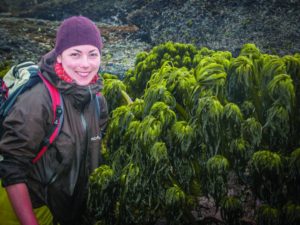Talk about cult classic. Pacific Seaweeds: A Guide to Common Seaweeds of the West Coast was originally published 15 years back, to the delight of… one would imagine very few, as this is about as niche as niche gets. But here we are, a decade and a half later, and the book has sold 10,000 copies. Its legacy is so enduring that Harbour Publishing has seen fit to release a new and expanded version, with original author Louis D. Druehl bringing on Bridgette E. Clarkston to help out with this edition.
Clarkston calls Druehl a “long-time mentor” and says it’s an “absolute honour” to be published with him.
“Seeing the updated Pacific Seaweeds in print is wonderful,” she says. “We’ve built upon the terrific first edition by including over 100 new seaweed species, a whole new section on shore plants, new recipes, and dozens of colourful photographs showcasing the diversity and beauty of our seaweed flora.”
Alright, so, let’s cut to the chase: why should college students care about seaweed? Clarkston is careful to point out that she won’t tell anyone they “should” care about seaweed, because no one responds well to being told they should do anything. But, yes, college students might want to care.

“I will say that college students, just like everybody else, have an innate connection to and curiosity about the natural world,” she says. “In my experience, not caring about seaweeds often comes from not knowing anything about them. Seaweeds are major players in coastal ecosystems. They perform similar roles that plants do on land, creating the basis of many food webs as well as the underwater forests and meadows that provide homes and shelters for marine fish, invertebrates, and other animals. Humans have used seaweeds for thousands of years, and today is no different: food, chemical extracts, fertilizers, cosmetics, pharmaceuticals, and more.”
All of which makes a good case, but I still have to admit to Clarkston that I think seaweed is just basically kinda gross. She says that’s due to the seaweed that most of us encounter on the beach not being the most glorious of specimens.
“I suspect that most seaweeds you’ve encountered have been washed up on the beach, perhaps after a winter storm. Did you know this is essentially the seaweed equivalent of roadkill? No wonder you find it kinda gross,” she says. “The vast majority of seaweeds grow attached to something—rocks, animals, other seaweeds. Strong waves, especially in the winter, easily dislodge seaweeds and sweep them ashore, often in concentrated piles known as ‘wrack.’ Exposed to air and sun, this wrack begins to decompose, becoming smellier over time. This leads to seaweeds getting, in my opinion, an unfair reputation as being ‘gross.’”
Consider me sold. The book’s passion for seaweed and the level of detail the authors go into is helping, too (the photos are excellent, as well). Plus, Clarkston once named a species of seaweed she discovered after director Tim Burton, so maybe there’s something to this subculture after all.
“Next time you’re at the beach, look for seaweeds that are still alive, attached to rocks, and try to keep an open mind,” says Clarkston. “You’d be surprised how quickly they grow on you.”
No comment.
